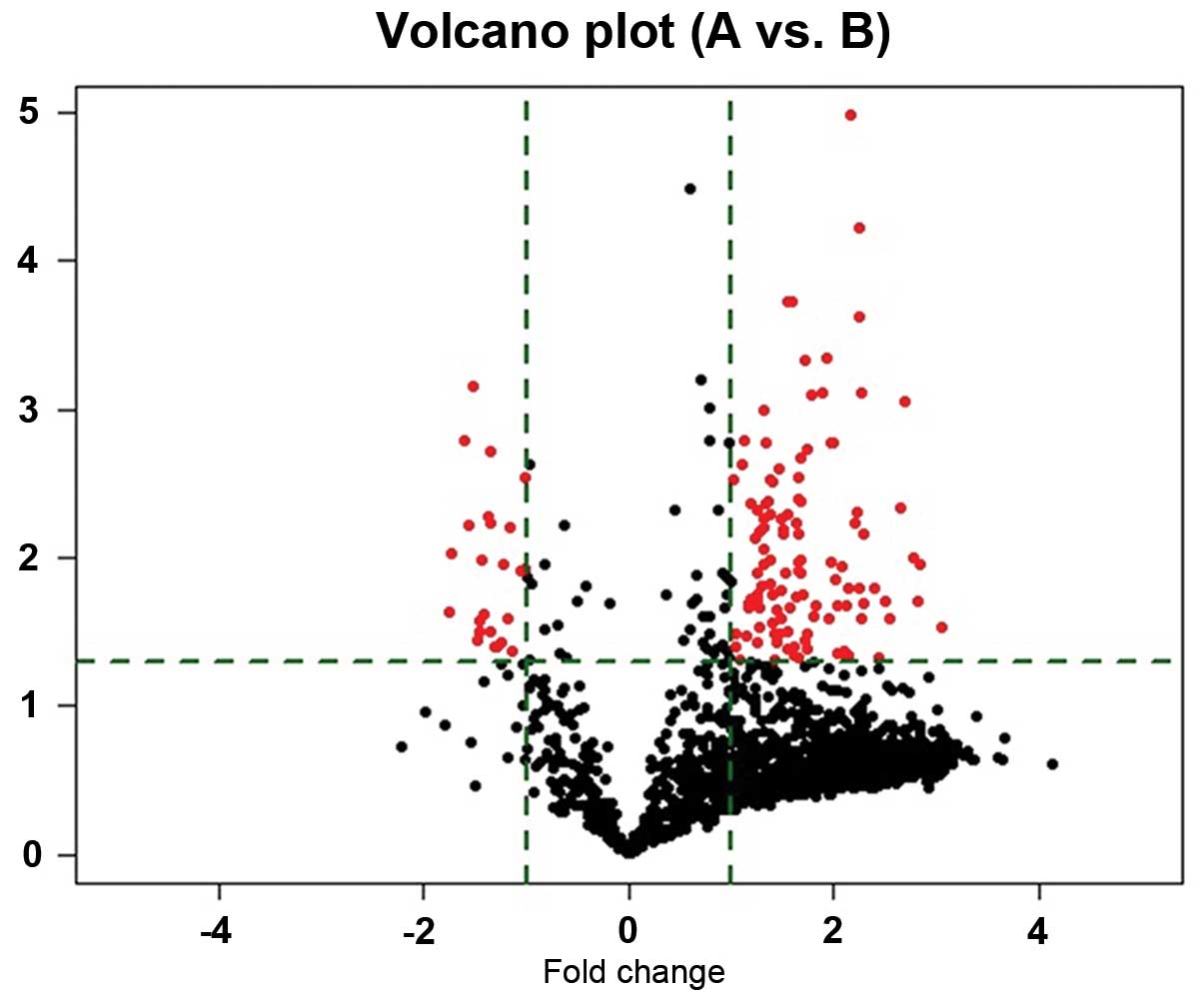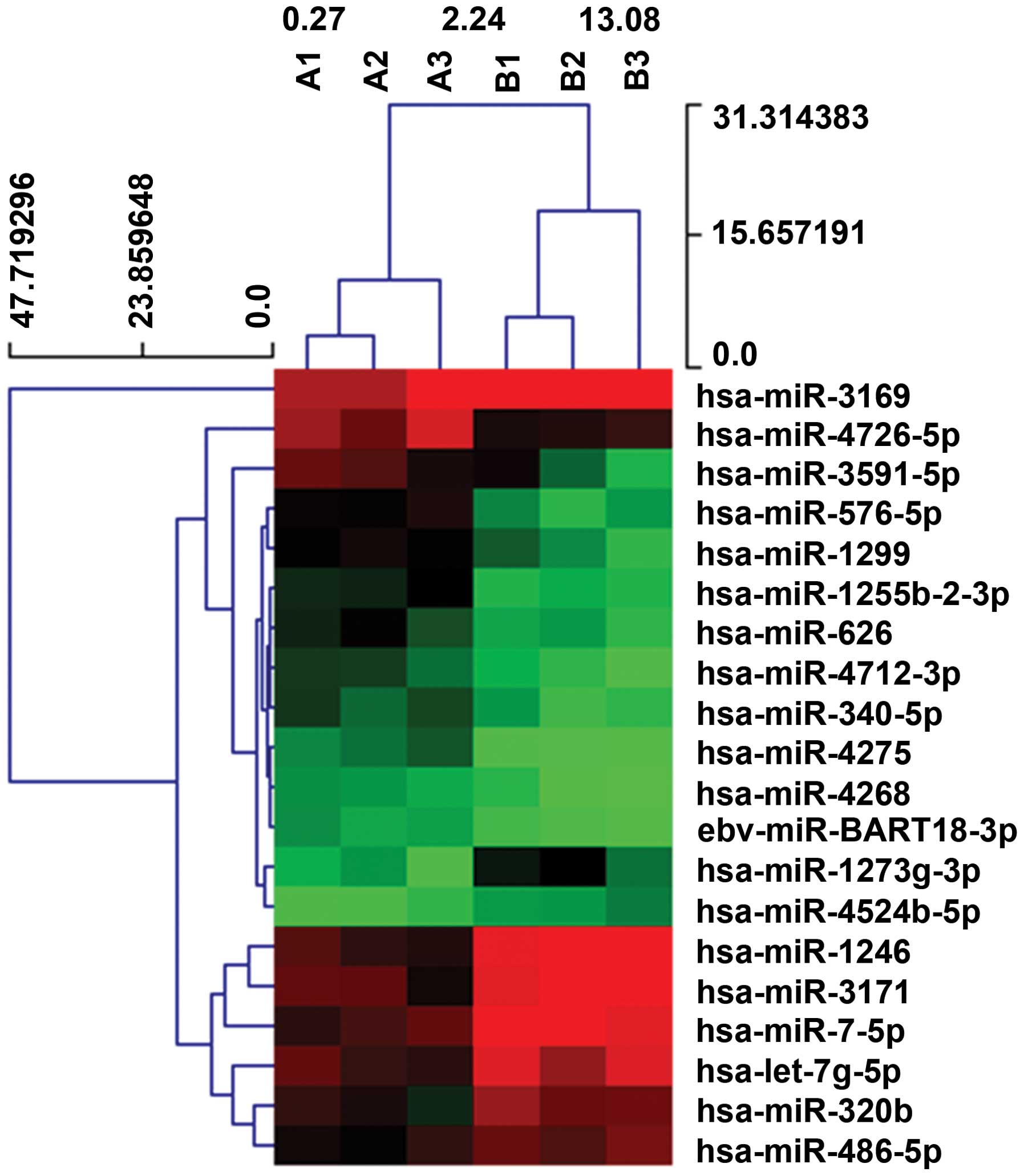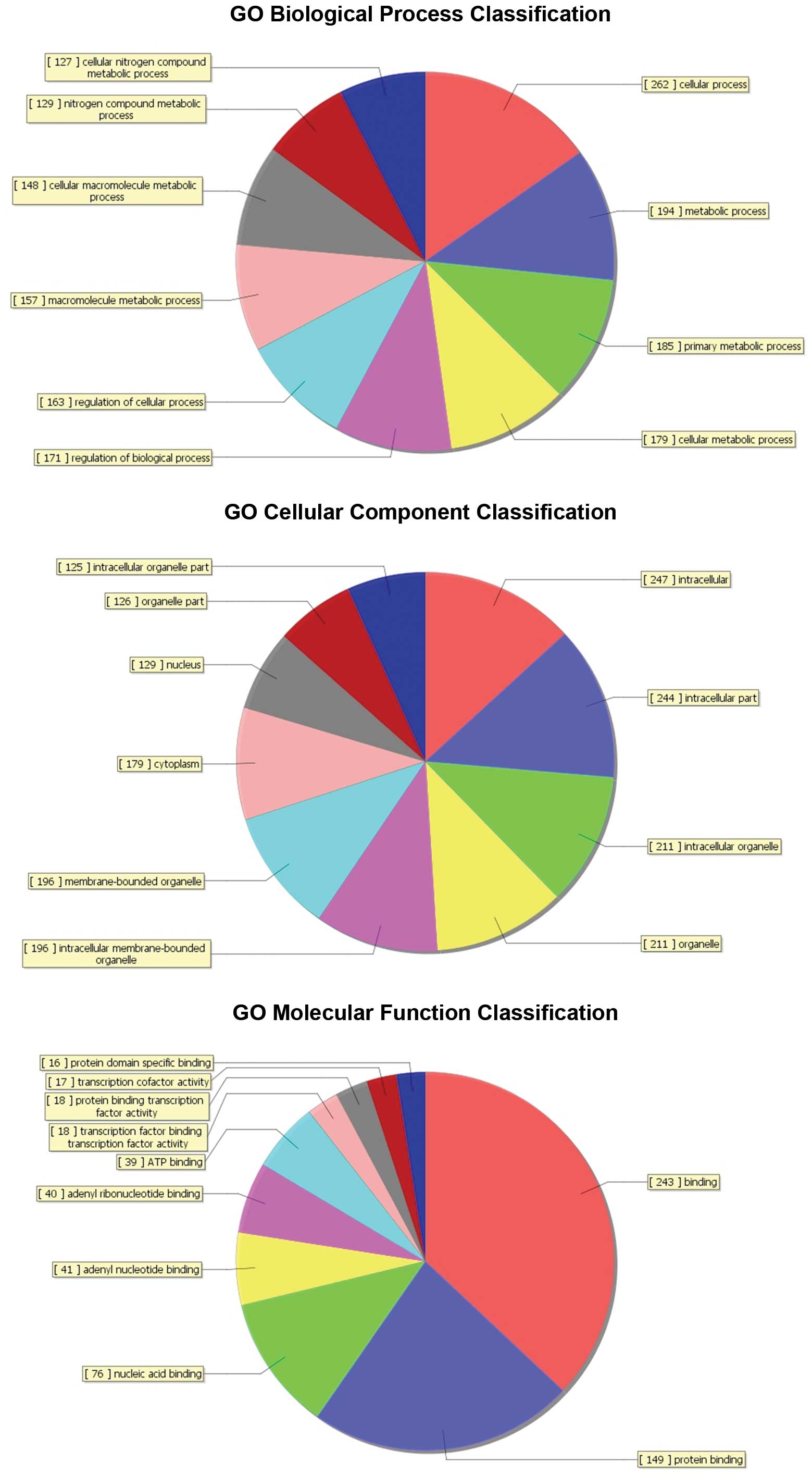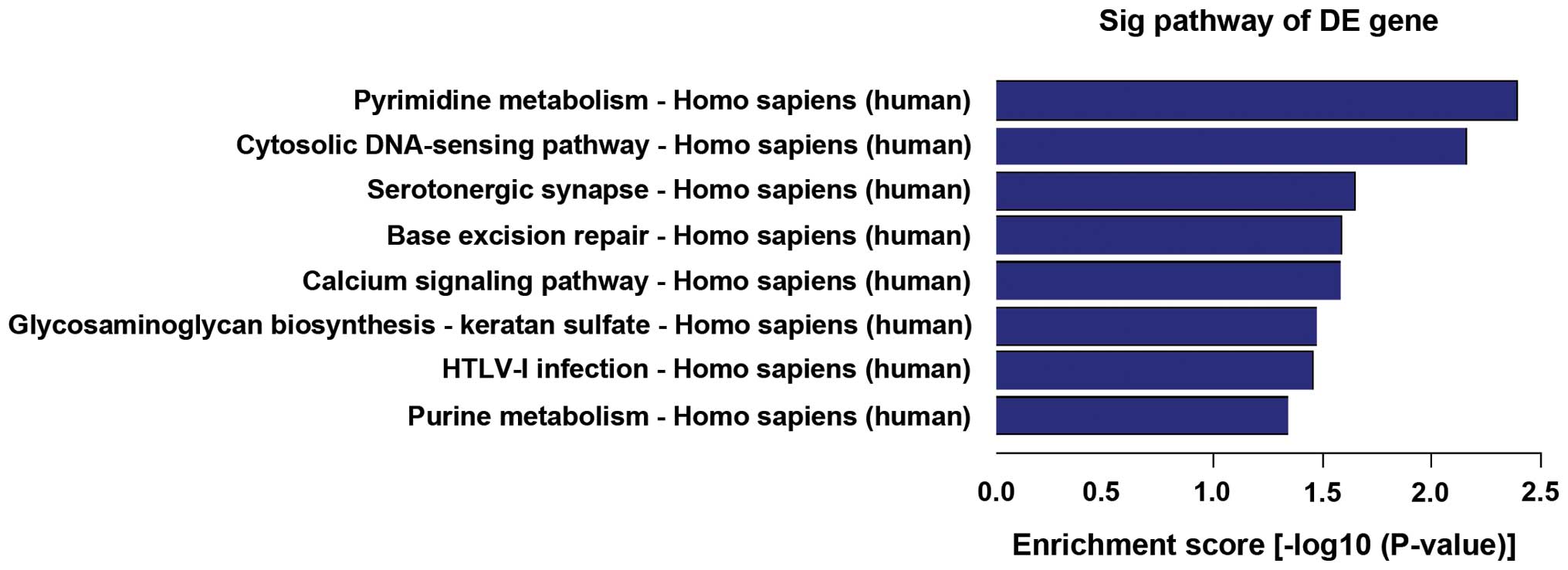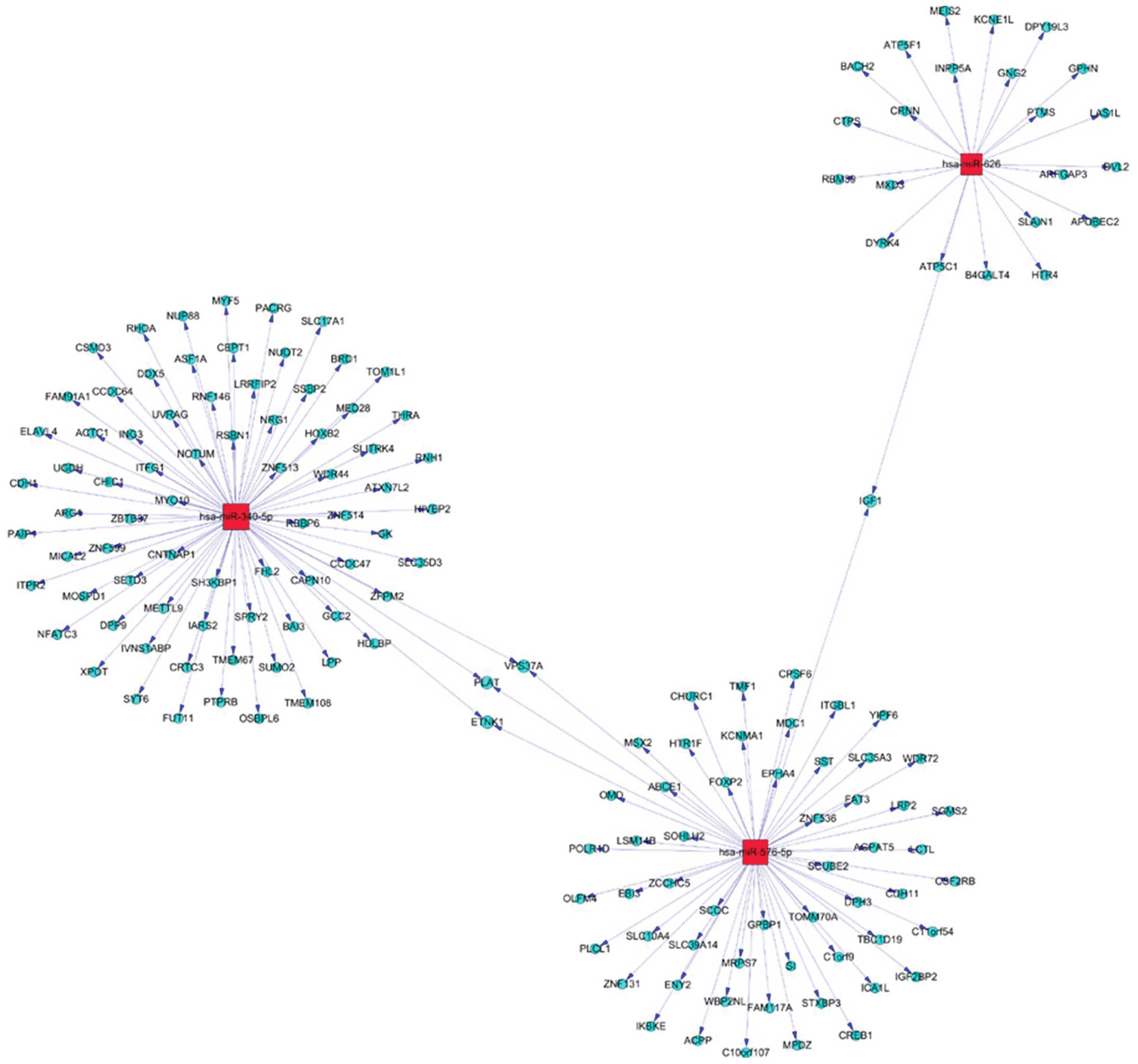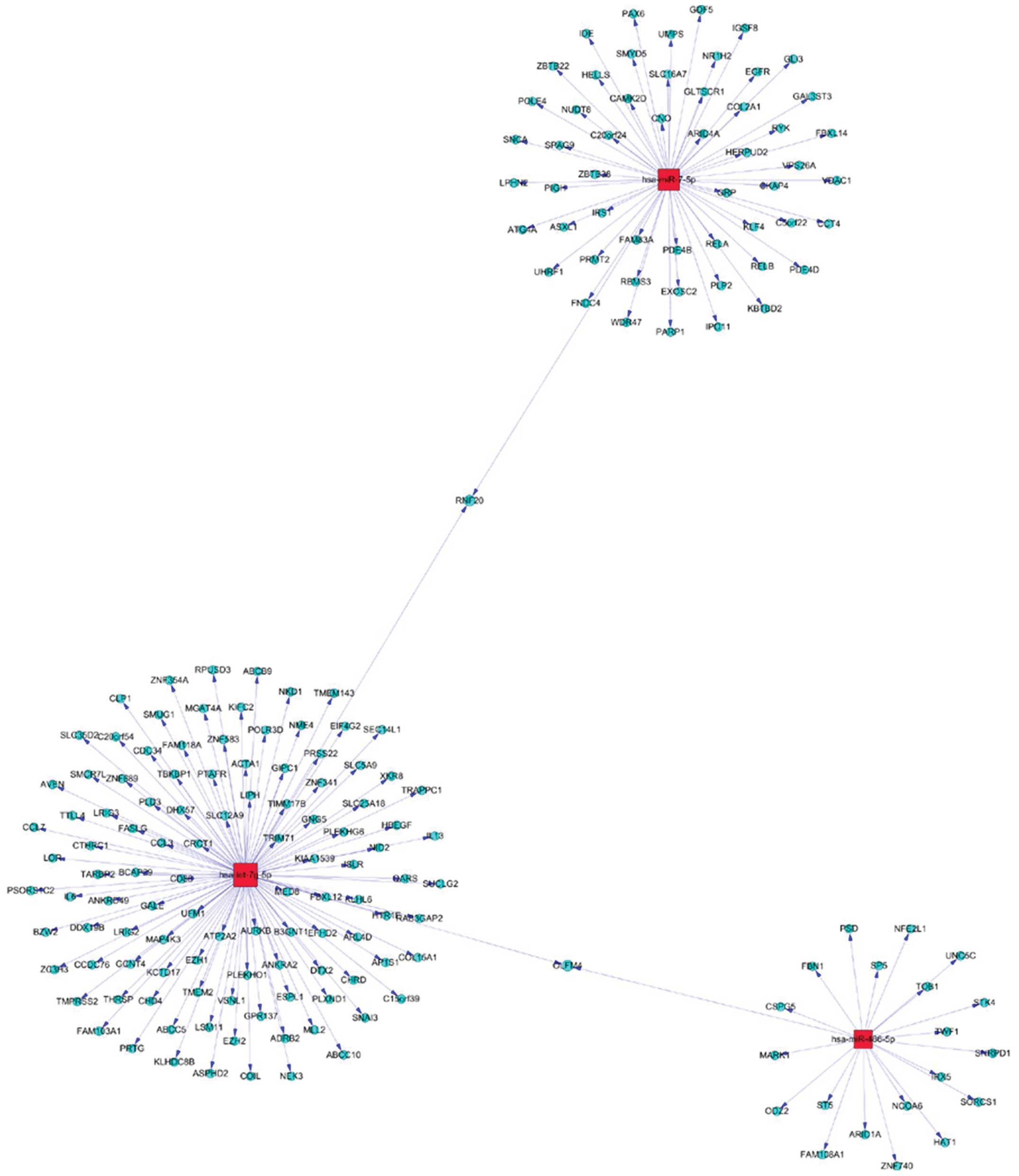miRNA microarray reveals specific expression in the peripheral blood of glioblastoma patients
- Authors:
- Published online on: May 22, 2014 https://doi.org/10.3892/ijo.2014.2459
- Pages: 746-756
Abstract
Introduction
GBM is the most common and aggressive primary brain tumor with high mortality and morbidity. The prognosis for malignant gliomas has not significantly improved in the last four decades (1,2). In the past two decades, the molecular mechanisms, genetics and pathways to treat GBM have extensively been studied. However, the precise mechanism of GBM is unknown and its median survival rate is very low (3,4). The early detection and assessment of GBM pathologies still need to be solved.
MicroRNAs are 21–25 nucleotide small, non-coding RNAs that post-transcriptionally repress the expression of protein-coding genes through binding to the 3′ untranslated regions (UTR) of the target mRNAs (5–9). Accumulated evidence indicates that miRNAs are important in the regulation of many biological processes, such as developmental timing, cell metabolism, cell differentiation, cell death, cell proliferation, haematopoiesis and patterning of the nervous system (10). In the past several years, the importance of microRNAs (miRNAs) in cancer cells has been recognized. Proper control of miRNA expression is essential for maintaining a steady state. The stenoplastic existence of circulating miRNAs in the blood of cancer patients has raised the possibility that miRNAs may serve as a novel diagnostic marker (11).
In this study, we profiled miRNAs expression in the peripheral blood of GBM and healthy humans by microarray. The differentially expressed miRNAs were analyzed, then selected to bioinformatic analyses of target prediction. The predicted target genes were subjected to bioinformatic analyses, including gene ontology and pathway analyses. Analyzing the potential molecular markers and the possible relationship between the differentially expressed protein-coding genes and miRNAs in periopheral blood of GBM will help to give further insight into the pathogenesis of GBM.
Materials and methods
Sample preparation and RNA extraction
Selection of subjects, study design and blood sampling. The miRNA profiles from 3 circulating blood samples of GBM patients and 3 age- and gender-matched healthy controls from donors without GBM were obtained according to clinical protocols at the clinical medical college of Yangzhou University. All subjects were generally in good health, and none had diabetes or any other serious concomitant diseases. The patients had not received prior treatment. Following informed consent at the time of acquisition, the samples were collected, and stored at liquid nitrogen. Blood for plasma preparation was collected using a 19-gauge needle into vacutainers containing 0.129 M sodium citrate (1 volume anticoagulant and 9 volumes whole blood) as anticoagulant, centrifuged at 2000 g for 15 min at 22°C, transferred into sterile cryovials in aliquots of 1 ml and stored at −70°C until further analysis. RNA extractions from plasma and all qPCRs were performed by Exiqon Services (Vedbaek, Denmark). Total-RNA was extracted from plasma using miRNeasy Mini kits. Plasma was thawed on ice and centrifuged (1000 × g; 5 min; 4°C). Plasma (200 μl) was mixed with 750 μl of Qiazol containing 0.94 μg/μl of MS2-bacteriophage (incubated for 5 min, room temperature). Samples were chloroform extracted, ethanol precipitated, transferred to RNeasy Mini columns and washed according to the manufacturer’s protocols. RNA was eluted in 50 μl RNase-free water.
MicroRNA real-time PCR array
Human panelI+II v3 (the 752 micRNAs) miRCURY LNA™ Universal RT miRNA PCR array were obtained from the manufacturers. The qRT-PCR-based platforms promise to be more sensitive than array-based miRNA quantification platforms (12), and their use for analyzing samples with low miRNA levels, such as human plasma, is increasing (13–18).
RNA was reversely transcribed using miRCURY LNA Universal RT microRNA PCR, polyadenylation and cDNA synthesis kit (Exiqon, Vedbaek, Denmark). PCR reactions (10 μl) were performed according to the miRCURY LNA Universal RT microRNA PCR protocol; each miRNA was assayed once on microRNA Ready-to-Use PCR Human panel I+II (Exiqon, Kangchen, China). Controls included primers for six independent reference genes, including 3 microRNAs (hsa-miR-103, hsa-miR-191 and hsa-miR-423-5p), and 3 small RNA (U6, SNORD38B and SNORD49A).
The amplification profile was denatured at 95.8°C for 10 min, followed by 40 cycles of 95.8°C for 10 sec and 60.8°C for 60 sec. At the end of the PCR cycles, melting curve analyses were performed. All reactions were done in triplicate. Amplification efficiency was calculated using algorithms similar to LinReg (Exiqon, Vedbaek, Denmark). All assays were inspected for distinct melting curves and melting temperatures were checked to be within known assay specifications. Expression levels of mature mRNAs were evaluated using comparative CT method (2−ΔCT) (19). Raw Ct values were calculated as recommended by Exiqon Negative controls, without enzymes, from the reverse transcription reaction was treated and profiled. Data that did not pass these criteria were omitted from any further analysis.
Statistical analysis
The approximate normal distribution of the measured data was verified by Shapiro-Wilk test. Data are expressed as the mean ± SD unless otherwise noted. The differences between groups were analyzed using by unpaired two-tailed parametric t-test when only two groups were present and the null hypothesis was rejected at the 0.05 level. The correlation between two dichotomous variables was assessed using Fisher’s exact test. The enrichment P-value of the PathwayID used Fisher’s exact test.
Results
Differentially expressed miRNAs in glioma patients
Altogether, 752 mature miRNAs were quantitatively analyzed using a microarray platform. Following background subtraction and quantile normalization, all miRNAs with median intensity below 100 were considered lowly abundant and removed. The remaining 139 miRNAs (fold change ≥2.0) were then analyzed using computational approaches (Fig. 1). Compared to peripheral blood of control cases, we observed significant deregulation of 139 miRNAs, 115 miRNAs were upregulated (83%) (Table I), whereas 24 miRNAs were downregulated (17%) (Table II). Especially three miRNAs, the miR-576-5p, miR-340, miR-626, the most upregulated and miR-320, let-7g-5p, miR-7-5P, the most downregulated miRNA, in glioma patients. Of the six miRNAs, miR-576-5p displayed a 3.05-fold increased median expression in samples from glioblastoma patients compared to healthy controls. The expression level of miR-7-5P was decreased in the glioblastoma patients to 0.37-fold compared with the healthy donors.
Prediction of targets of differentially expressed miRNA and function annotation in peripheral blood of GBM patients
To understand the potential functions of significantly differentially expressed miRNA in the GBM, and to further explore the function of these predicted target genes, we selected the most upregulated coherent 12 miRNAs (hsa-miR-4726-5p, hsa-miR-1255b-2-3p, hsa-miR-340-5p, hsa-miR-4275, hsa-miR-4712-3p, hsa-miR-576-5p, hsa-miR-1299, hsa-miR-4268, hsa-miR-3591-5p, hsa-miR-626, hsa-miR-BART18-3p, hsa-miR-3169), and the most downregulated coherent 8 miRNAs (hsa-miR-320b, hsa-let-7g-5p, hsa-miR-486-5p, hsa-miR-7-5p, hsa-miR-4524b-5p, hsa-miR-3171, hsa-miR-1246, hsa-miR-1273g-3p) to perform Gene Ontology analysis and pathway analysis.
To understand the potential functions of significantly differentially expressed miRNA in glioma patients, various biological process terms of genes were predicted as the potential targets of these 20 miRNAs in the peripheral blood of glioma patients by using bioinformatics method (Fig. 2). To further explore the function of these predicted target genes. The predicted target genes in Gene Ontology (GO) which covers three domains of the 20 miRNAs: biological process, cellular component and molecular function (Fig. 3) biological process terms were enriched with cellular catabolic process and cellular process. In cellular component category, GO terms related to the cytoplasmic part, membrane-bounded organelle, intracellular membrane-bound organelle, organelle, intracellular organelle, cytoplasm and intracellular organelle part. The molecular function category of GO terms showed the major functions. Binding, myosin binding, protein transporter activity, serotonin receptor activity, histone methyltransferase activity, transcription factor binding, transcription factor activity, retinoic acid receptor binding, protein binding transcription factor activity, protein binding, transcription cofactor activity, protein kinase activator activity, acetylglucosaminyltransferase activity. To detect these 20 miRNA pathways, whose members are significantly enriched for targets of the 20 miRNAs being deregulated, we utilized the ‘miRNA to pathway dictionary’ (20). All the significant target pathways are listed for the miRNA in Fig. 4 and related to pyrimidine metabolism, cytosolic DNA-sensing pathway, serotonergic synapse, base excision repair, calcium signaling pathway, glycosaminoglycan biosynthesis, keratan sulfate, HTLV-I infection and purine metabolism. These have been computed by separately applying standard over-representation analysis for each set of miRNA targets, a gene network analysis was applied to the upregulation of miR-576-5p, miR-340, miR-626 (Fig. 5), and downregulation miR-320, let-7g-5p and miR-7-5P (Fig. 6).
Discussion
Gliomas are the most commonly diagnosed cancers in the brain. Following therapy, progression or recurrence is often observed. In addition to imaging studies, that are normally only available every 2–3 months, biomarkers might be helpful monitoring tools to detect tumor recurrence at the earliest time point or to distinguish between pseudoprogression and substantial tumor growth.
It has been found that a large part of the human genome is transcribed into non-coding RNAs with major functions both in normal physiology and in pathological processes (21,22). Recent studies have shown the contribution of miRNAs to cancer pathogenesis (23). miRNAs have the advantage of being clearly defined markers that can easily be determined by microarrays or real-time PCR. The function of miRNAs appears to be in gene regulation where they act as post-transcriptional regulators and control the target messenger RNAs (mRNAs). Perfect or near perfect base pairing with the target RNA promotes cleavage and destruction of the mRNA, whereas miRNAs that are only partially complementary to the target may inhibit protein translation of mRNA and also cause the mRNAs to be degraded sooner (24). The mRNA is thus ‘silenced’ and the protein coded for not produced. miRNAs therefore generally have an ‘inhibitory’ function (25). In this way, miRNAs appear to have various functions in physiology, from cell differentiation, proliferation and apoptosis to the regulation of the endocrine system and metabolism (12,26). Although the miRNA analysis can be performed by broadly available technologies that are already in clinical use, but these associations are based on studies in tissue samples. However, such tissue samples are not easily obtained, and a more effective step forward was found when miRNAs were detected to be remarkably stable in serum or plasma (27,28). miRNAs have the advantage of being clearly defined markers that can easily be determined by microarrays or real-time PCR in peripheral blood. The ease of the methods further opens the road for the analysis of specific miRNA patterns that comprise numerous miRNAs.
In this study, initial analysis of the miRNAs profiling showed that some miRNAs were differentially expressed in GBM patients and these miRNAs can be distinguished from normal individuals. We identified 139 miRNAs that were significantly expressed, 115 miRNAs were found to be upregulated whereas 24 were downregulated. Our results were partly in disagreement with Roth et al (20). When comparing the filtered repertoire of the 310 miRNAs in glioblastoma patients and healthy controls, they observed a significant deregulation of 52 miRNAs, amounting to 16.8% of analyzed miRNAs. Of these, 27 miRNAs were upregulated (52%) whereas 25 miRNAs were downregulated (48%). The microarray analysis also showed that there was no significantly distinct difference in the 613 common miRNA expression profiles between these two conditions. This could be explained by the fact that both conditions have undergone genetic normalities. It is also probable that both conditions share similar genetic pathways through the regulation of specific gene expression. We identified that miR-576-5p, miR-340, miR-626 and miR-320, let-7g-5p and miR-7-5P were significantly deregulated only in the blood of GBM but not in the blood of normal inviduals, suggesting a possible role in gliomas cell growth and proliferation. For example, miR-342-3p, the second most deregulated miRNA, has not been investigated in glioma tissues. The results of Li et al indicated that an overexpression of miR-576-5 occurred in brain-metastatic carcinomas (29), whereas, miR-576-5p was downregulated in osteoarthritis (OA) chondrocyte pellets with the highest fold-change of 4.74-fold (30), but the miR-576-5p was overexpressed in the the serum of glioma patient in this study. A number of recent studies have demonstrated that miR-7 inhibits cell migration and metastasis in glioblastoma (31,32). Recent advances in miRNA delivery and targeting suggest that ‘miRNA replacement therapy’ with miR-7-5p may be a feasible approach to cancer treatment (33). Giles et al demonstrated that miR-7-5p expression is reduced in metastatic melanoma-derived cell lines compared with primary melanoma cells, and that ectopically expressed miR-7-5p significantly inhibits melanoma cell migration and invasion. Additionally, it was reported that insulin receptor substrate-2 (IRS-2) is a target of miR-7-5p in melanoma cells. By using RNA interference (RNAi) evidence was provided that IRS-2 activates protein kinase B (Akt), and promotes melanoma cell migration. Thus, miR-7-5p may represent a novel tumor suppressor miRNA in melanoma, acting at least in part via its inhibition of IRS-2 expression and oncogenic Akt signaling (34). In the present report the miR-7-5p, significantly deregulated miRNA in the peripheral blood of GBM patient, but has not yet been seriously investigated in glioma tissues.
Subsequently, a futher step was added to our study, GO analysis and pathway analysis. The GO analysis included biological process, molecular function and cellular components. Pathway analysis was used to generate networks and assess statistically relevant biofunctions and canonical pathways that predicted target genes involved. These genes were mapped to corresponding genes in the Ingenuity knowledge database. The biofunctional analysis identified the molecular and cellular function, physiological system development and function. Canonical pathway analysis identified the most significant pathways in the dataset.
There were previous reports on expression in plasma or serum miRNA profile of glioma (20,27). We found 20 miRNAs either up- or down regulated which were significant different. We would have preferred to do a complete miRNA profiling by RT-qPCR in all the 139 subjects, but due to high costs this was not possible. We only analyzed significantly different 20 miRNAs in the main study. An additional factor was that inclusion of more than 100 miRNAs would have made it very much difficult to evaluate whether an observed change was truly significant or simply due to chance because of a large number of miRNA analyzed. Instead we selected the most promising 20 miRNAs that had shown a significant expression change. Of these 20 miRNAs, only miR-576-5p, miR-340, miR-626, miR-320, let-7g-5p and miR-7-5P were included in this GO analysis and pathway analysis. Furthermore, in a study on glioma where RNA had been extracted and purified from whole blood, showed different expression. Normal biological variation of miRNA levels in plasma together with variation introduced during sample treatments (from blood sampling to RT-qPCR) may affect the observed expression of miRNAs (35). Also in the initial report on miRNA in serum, most of the miRNAs were detected in both serum and blood cells. However, only a small number of miRNAs were uniquely present in either serum or blood cells, indicating that most serum miRNAs may be derived from circulating blood cells (28,36). In addition, the miRCURY LNA RT-qPCR system used for detection of known plasma miRNAs has been found to be more sensitive and reproducible than the initial microarray systems and show even more sensitivity and linearity than TaqMan methods at low concentration of plasma miRNA (37,38).
Previous studies on identifying serum miRNA-based biomarkers generally focused on individual miRNA. However, the specificity of biomarkers based on a single miRNA is generally questionable and poor (27,28). In this study, it showed that the combination of six significantly diverse serum miRNAs would be a more comprehensive indicator for the diagnosis of GBM, however, it has not yet been precisely investigated in the tissues or serum of glioma patient. There are several limitations in our study. Firstly, the sample size is small. Whether this six-member serum miRNA profile can be established as a routine biomarker for pertussis diagnosis will require more investigation. Secondly, the testing of a large number of clinical samples will be required to compare and confirm the results of this study. Finally, we only evaluated partially the dysregulated miRNAs, thus some miRNAs other than those reported herein might also be identified as serum biomarkers for GBM diagnosis in future studies.
The secretory mechanism and biological function, as well as the meaning of the existence of extracellular miRNAs, remain largely unclear. Because of the lack of any biomarker in peripheral blood that is in clinical use for glioblastoma, the findings of our study may provide the scientific basis for further studies using miRNAs for the follow-up of patients diagnosed with glioblastoma. Considering the biological relevance of miRNAs to GBM and recent studies of circulating miRNAs in serum by others, we hypothesize that the serum miRNAs may serve as novel biomarkers for the diagnosis and evaluation of GBM.
Collectively, we have demonstrated that a unique six-member serum miRNA expression profile could serve as a non-invasive biomarker for GBM diagnosis.
Acknowledgements
The authors thank Shizhu Yu, Department of Neuropathology, Neurology Institute, Tianjin Medical University General Hospital, Tianjin Neurological Institute, China, for his technical assistance.
References
|
Tzadok S, Beery E, Israeli M, et al: In vitro novel combinations of psychotropics and anti-cancer modalities in U87 human glioblastoma cells. Int J Oncol. 37:1043–1051. 2010. | |
|
Han L, Zhang K, Shi Z, et al: LncRNA profile of glioblastoma reveals the potential role of lncRNAs in contributing to glioblastoma pathogenesis. Int J Oncol. 40:2004–2012. 2012.PubMed/NCBI | |
|
Wang Y, Chen L, Bao Z, et al: Inhibition of STAT3 reverses alkylator resistance through modulation of the AKT and β-catenin signaling pathways. Oncol Rep. 5:1173–1180. 2011.PubMed/NCBI | |
|
Wang LF, Fokas E, Bieker M, et al: An HX Increased expression of EphA2 correlates with adverse outcome in primary and recurrent glioblastoma multiforme patients. Oncol Rep. 19:151–156. 2008. | |
|
Bartel DP: MicroRNAs: genomics, biogenesis, mechanism, and function. Cell. 23:281–297. 2004. View Article : Google Scholar : PubMed/NCBI | |
|
Ambros V: The functions of animal microRNAs. Nature. 16:350–355. 2004. View Article : Google Scholar | |
|
Grimson A, Farh KK, Johnston WK, et al: MicroRNA targeting specificity in mammals: determinants beyond seed pairing. Mol Cell. 27:91–105. 2007. View Article : Google Scholar : PubMed/NCBI | |
|
He L and Hannon GJ: MicroRNAs: small RNAs with a big role in gene regulation. Nat Rev Genet. 5:522–231. 2004. View Article : Google Scholar : PubMed/NCBI | |
|
Kim VN: MicroRNA biogenesis: coordinated cropping and dicing. Nat Rev Mol Cell Biol. 6:376–385. 2005. View Article : Google Scholar : PubMed/NCBI | |
|
Zhao C, Tian F, Yu Y, et al: miRNA-dysregulation associated with tenderness variation induced by acute stress in Angus cattle. J Anim Sci Biotechnol. 3:12–17. 2012. View Article : Google Scholar : PubMed/NCBI | |
|
Cuellar TL and McManus MT: MicroRNAs and endocrine biology. J Endocrinol. 187:327–332. 2005. View Article : Google Scholar : PubMed/NCBI | |
|
Poy MN, Eliasson L, Krutzfeldt J, et al: A pancreatic islet-specific microRNA regulates insulin secretion. Nature. 432:226–230. 2004. View Article : Google Scholar : PubMed/NCBI | |
|
Cheng H, Zhang L, Cogdell DE, et al: Circulating plasma MiR-141 is a novel biomarker for metastatic colon cancer and predicts poor prognosis. PLoS One. 6:e177452011. View Article : Google Scholar : PubMed/NCBI | |
|
Ng EK, Chong WW, Jin H, et al: Differential expression of microRNAs in plasma of patients with colorectal cancer: a potential marker for colorectal cancer screening. Gut. 58:1375–1381. 2009. View Article : Google Scholar : PubMed/NCBI | |
|
Rabinowits G, Gercel-Taylor C, Day JM, et al: Exosomal microRNA: a diagnostic marker for lung cancer. Clin Lung Cancer. 1:42–46. 2009. View Article : Google Scholar : PubMed/NCBI | |
|
Resnick KE, Alder H, Hagan JP, et al: The detection of differentially expressed microRNAs from the serum of ovarian cancer patients using a novel real-time PCR platform. Gynecol Oncol. 112:55–59. 2009. View Article : Google Scholar : PubMed/NCBI | |
|
Taylor DD and Gercel-Taylor C: MicroRNA signatures of tumor-derived exosomes as diagnostic biomarkers of ovarian cancer. Gynecol Oncol. 110:13–21. 2008. View Article : Google Scholar : PubMed/NCBI | |
|
Yaman Agaoglu F, Kovancilar M, Dizdar Y, et al: Investigation of miR-21, miR-141, and miR-221 in blood circulation of patients with prostate cancer. Tumour Biol. 32:583–588. 2011.PubMed/NCBI | |
|
Li W1, Yuan Y, Huang L, et al: Metformin alters the expression profiles of microRNAs in human pancreatic cancer cells. Diabetes Res Clin Pract. 96:187–195. 2012. View Article : Google Scholar : PubMed/NCBI | |
|
Roth P, Wischhusen J, Happold C, et al: A specific miRNA signature in the peripheral blood of glioblastoma patients. J Neurochem. 118:449–457. 2011. View Article : Google Scholar : PubMed/NCBI | |
|
Kapranov P, Cheng J, Dike S, et al: RNA map reveals new RNA classes and a possible function for persvasive transcription. Science. 316:1484–1488. 2007. View Article : Google Scholar : PubMed/NCBI | |
|
Taft RJ, Pang KC, Mercer TR, et al: Non-coding RNAs: regulators of disease. Pathology. 220:126–139. 2010. View Article : Google Scholar : PubMed/NCBI | |
|
Zhang W, Edwards A, Fan W, et al: miRNA-mRNA correlation-network modules in human prostate cancer and the differences between primary and metastatic tumor subtypes. PLoS One. 7:e401302012. View Article : Google Scholar | |
|
Williams AE: Functional aspects of animal microRNAs. Cell Mol Life Sci. 65:545–562. 2008. View Article : Google Scholar : PubMed/NCBI | |
|
Place RF, Li LC, Pookot D, et al: MicroRNA-373 induces expression of genes with complementary promoter sequences. Proc Natl Acad Sci USA. 105:1608–1613. 2008. View Article : Google Scholar | |
|
Brennecke J, Hipfner DR, Stark A, et al: Bantam encodes a developmentally regulated microRNA that controls cell proliferation and regulates the proapoptotic gene hid in Drosophila. Cell. 113:25–36. 2003. View Article : Google Scholar : PubMed/NCBI | |
|
Chen X, Ba Y, Ma L, et al: Characterization of microRNAs in serum: a novel class of biomarkers for diagnosis of cancer and other diseases. Cell Res. 18:997–1006. 2008. View Article : Google Scholar : PubMed/NCBI | |
|
Kosaka N, Iguchi H and Ochiya T: Circulating microRNA in body fluid: a new potential biomarker for cancer diagnosis and prognosis. Cancer Sci. 101:2087–2092. 2010. View Article : Google Scholar : PubMed/NCBI | |
|
Li Z, Gu X, Fang Y, et al: microRNA expression profiles in human colorectal cancers with brain metastases. Oncol Lett. 3:346–350. 2012.PubMed/NCBI | |
|
Díaz-Prado S, Cicione C, Muiños-López E, et al: Characterization of microRNA expression profiles in normal and osteoarthritic human chondrocytes. BMC Musculoskelet Disord. 13:1442012.PubMed/NCBI | |
|
Giles KM, Brown RA, Epis MR, et al: miRNA-7-5p inhibits melanoma cell migration and invasion. Biochem Biophys Res Commun. 430:706–710. 2013. View Article : Google Scholar : PubMed/NCBI | |
|
Dong L, Han C, Zhang H, et al: Construction of a recombinant lentivirus containing human microRNA-7-3 and its inhibitory effects on glioma proliferation. Neural Regener Res. 7:2144–2150. 2012.PubMed/NCBI | |
|
Bader AG, Brown D and Winkler M: The promise of microRNA replacement therapy. Cancer Res. 70:7027–7030. 2010. View Article : Google Scholar : PubMed/NCBI | |
|
Giles KM, Brown RA, Epis MR, et al: miRNA-7-5p inhibits melanoma cell migration and invasion. Biochem Biophys Res Commun. 430:706–710. 2013. View Article : Google Scholar : PubMed/NCBI | |
|
McDonald JS, Milosevic D, Reddi HV, et al: Analysis of circulating microRNA: preanalytical and analytical challenges. Clin Chem. 57:833–840. 2011. View Article : Google Scholar : PubMed/NCBI | |
|
Jorde R, Svartberg J, Joakimsen RM and Coucheron DH: Plasma profile of microRNA after supplementation with high doses of vitamin D3 for 12 months. BMC Res Notes. 5:2452012. View Article : Google Scholar : PubMed/NCBI | |
|
Chen Y, Gelfond JA, McManus LM and Shireman PK: Reproducibility of quantitative RT-PCR array in miRNA expression profiling and comparison with microarray analysis. BMC Genomics. 10:4072009. View Article : Google Scholar : PubMed/NCBI | |
|
Jensen SG, Lamy P, Rasmussen MH, et al: Evaluation of two commercial global miRNA expression profiling platforms for detection of less abundant miRNAs. BMC Genomics. 12:4352011. View Article : Google Scholar : PubMed/NCBI |



